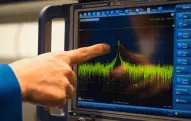NASA's Webb Telescope Reveals Carbon-Bearing Molecules on Exoplanet K2-18 b
 NASA's James Webb Space Telescope has made a groundbreaking discovery on the exoplanet K2-18 b, a celestial body 8.6 times the mass of Earth. The telescope's observations have unveiled the presence of carbon-bearing molecules, including methane and carbon dioxide, on this distant world. This finding adds weight to the growing hypothesis that K2-18 b might qualify as a Hycean exoplanet, a classification indicating the potential for a hydrogen-rich atmosphere and a surface covered by water oceans.
NASA's James Webb Space Telescope has made a groundbreaking discovery on the exoplanet K2-18 b, a celestial body 8.6 times the mass of Earth. The telescope's observations have unveiled the presence of carbon-bearing molecules, including methane and carbon dioxide, on this distant world. This finding adds weight to the growing hypothesis that K2-18 b might qualify as a Hycean exoplanet, a classification indicating the potential for a hydrogen-rich atmosphere and a surface covered by water oceans.
K2-18 b resides in the habitable zone of the cool dwarf star K2-18 and is located approximately 120 light-years away from Earth in the constellation Leo. Exoplanets like K2-18 b, falling within the size range between Earth and Neptune, remain enigmatic compared to the more familiar planets in our solar system. This category of planets, often referred to as "sub-Neptunes," presents an intriguing subject of study among astronomers due to their unique characteristics, particularly their atmospheres.
Initial insight into K2-18 b's atmospheric properties came from observations made by NASA's Hubble Space Telescope. These observations spurred further investigations, fundamentally reshaping our understanding of the exoplanet.
The notion that K2-18 b might belong to the class of Hycean exoplanets is captivating for astronomers, as some believe these planets could offer promising environments for the search for extraterrestrial life.
Lead author of the study, Nikku Madhusudhan, an astronomer at the University of Cambridge, stated, "Our findings underscore the importance of considering diverse habitable environments in the search for life elsewhere. Traditionally, the search for life on exoplanets has focused primarily on smaller rocky planets, but the larger Hycean worlds are significantly more conducive to atmospheric observations."
The abundance of methane and carbon dioxide, coupled with a scarcity of ammonia, lends support to the theory that K2-18 b may harbor a water ocean beneath a hydrogen-rich atmosphere. Additionally, the Webb observations hint at a potential detection of dimethyl sulfide (DMS), a molecule primarily associated with life on Earth. In our home planet's atmosphere, DMS is primarily emitted by phytoplankton in marine environments.
The detection of DMS on K2-18 b remains preliminary and requires further confirmation. Madhusudhan explained, "Upcoming Webb observations should be able to confirm if DMS is indeed present in the atmosphere of K2-18 b at significant levels."
Although K2-18 b resides within the habitable zone and has been found to host carbon-bearing molecules, it is essential to note that these factors alone do not guarantee the planet's ability to support life. The exoplanet's substantial size, with a radius 2.6 times that of Earth, suggests that its interior likely contains a substantial layer of high-pressure ice, resembling Neptune. Its atmosphere, while hydrogen-rich, is relatively thin, and it has a surface covered by an ocean. While Hycean worlds are predicted to have water oceans, the temperature of K2-18 b's ocean could potentially render it inhospitable or even non-liquid.
Team member Subhajit Sarkar of Cardiff University noted, "Although this kind of planet does not exist in our solar system, sub-Neptunes are the most common type of planet known so far in the galaxy. We have obtained the most detailed spectrum of a habitable-zone sub-Neptune to date, and this allowed us to work out the molecules that exist in its atmosphere."
Characterizing the atmospheres of exoplanets like K2-18 b is a challenging task due to the overwhelming brightness of their parent stars. To overcome this challenge, the team analyzed the light from K2-18 b's host star as it passed through the exoplanet's atmosphere. This unique technique, made possible by K2-18 b's status as a transiting exoplanet, has allowed astronomers to piece together information about the gases present in the exoplanet's atmosphere.
Madhusudhan emphasized the pivotal role played by Webb, stating, "This result was only possible because of the extended wavelength range and unprecedented sensitivity of Webb, which enabled robust detection of spectral features with just two transits. For comparison, one transit observation with Webb provided comparable precision to eight observations with Hubble conducted over a few years and in a relatively narrow wavelength range."
Savvas Constantinou of the University of Cambridge, another team member, added, "These results are the product of just two observations of K2-18 b, with many more on the way. This means our work here is but an early demonstration of what Webb can observe in habitable-zone exoplanets."
The team plans to conduct follow-up research using Webb's MIRI (Mid-Infrared Instrument) spectrograph to further validate their findings and gain additional insights into the environmental conditions prevailing on K2-18 b.
Madhusudhan concluded, "Our ultimate goal is the identification of life on a habitable exoplanet, which would transform our understanding of our place in the universe. Our findings are a promising step towards a deeper understanding of Hycean worlds in this quest." The results of this study have been accepted for publication in The Astrophysical Journal Letters.
Credits: Artist's impression illustration: NASA, CSA, ESA, J. Olmsted (STScI), Science: N. Madhusudhan (Cambridge University)









































